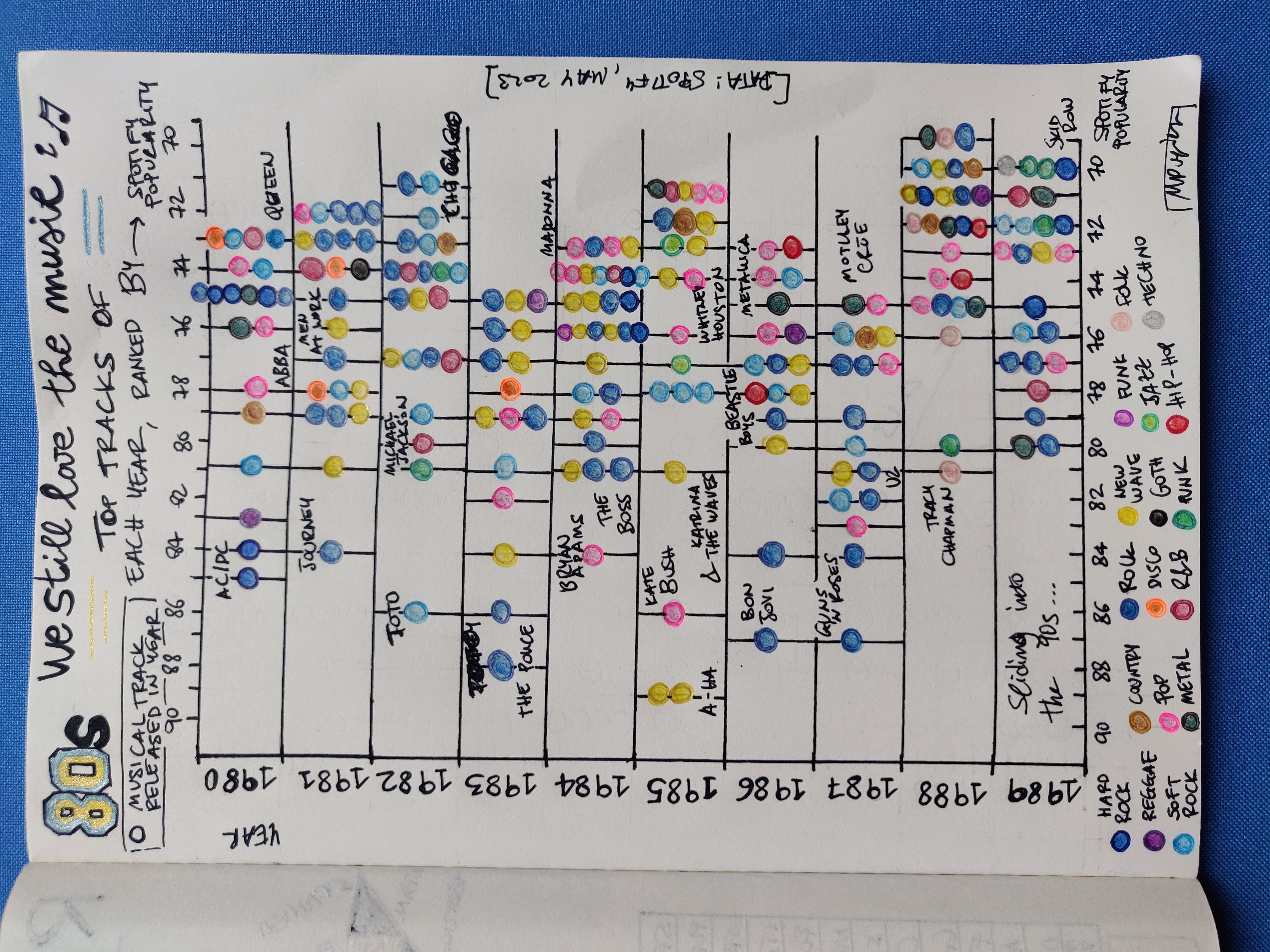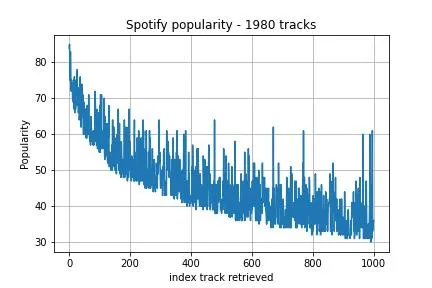Oh the ’80s, we still love the music
“Hell yeah” is Johnny Lawrence’s reaction at Ali’s Facebook message in which she wrote “I’m glad we went to high school in the ‘80s, no question we had the best music” [Cobra Kai, S3E6].
I‘m not sure that people born after, say, the year 2000 still listen to much ‘80s tunes (you tell me, if you’re reading) but it’s undeniable that many of us older definitely do, because a lot of great stuff has been produced in that decade. This was the era of new wave and electronic, the age when europop became a craze, but also a time characterised by a working balance between hard rock and mellow soft rock. Many belters (note: British English for something “awesome”) came out in the ‘80s.
In this viz, I’m showing data from Spotify about the songs produced in each of the years 1980-1989 that are still very popular today. This post will be followed by a second one with another viz that used the same data, so stay tuned (pun unintentional).

Each circle in the viz is a track, and tracks are separated by the year they were released. Only “top” tracks for each year are shown, where “top” means they are popular and loved on Spotify right now (details on this in the technical part below, if you’re interested). Tracks are coloured by the artist’s genre and genres are all listed at the bottom.
Tracks are ranked by popularity and I’ve chosen to represent 10 ranks - there can be tracks with identical popularity, so you see some “piles” of tracks together.
One caveat: I have only considered tracks in the English language (regardless of the nationality of the singers/bands). There were indeed a few popular tunes in other languages, mostly Spanish (e.g. “Devuélveme a mi chica” by Hombres G or “Cuando Pase El Temblor” by Soda Stereo, both released in 1985), I have excluded those under the idea that their popularity wouldn’t necessarily be global. Another great tune that was excluded is “99 Luftballons” by Nena.
A note on genre: assigning genre is not a clear-cut decision. I have taken Spotify’s genres, but an artist/band may come with more than one, so I’ve used my best judgement to choose the most representative, which adds some subjectivity in this data. For instance, AC/DC are tagged with “hard rock” (my choice), but also “rock” and “Australian rock” (not a genre per se, more an additional piece of info); Queen come with “rock” (my choice), “glam rock” and “classic rock” (which is the non-coeval classification we give today to rock from the past); ABBA are “europop” and “Swedish pop” but I’ve chosen to represent them as “pop”; “Men at Work” come with a lot of genre tags including “soft rock” and “mellow gold” out of which I’ve chosen “new wave”.
So, we unsurprisingly see a lot of rock, between generic (Bon Jovi, Bruce Springsteen, Journey, …), hard rock (AC/DC, Poison,…) and soft rock (Chicago, Fleetwood Mac, TOTO, …). There’s some metal (Metallica, Motley Crüe,…) and some pop (ABBA, Madonna, Bryan Adams, …), and there’s also some great R&B, reggae, country (Dolly Parton’s “9to5” is there) and folk tunes (a few entries from Tracy Chapman). But the most ‘80s thing is probably the many new wave songs (Men at Work, Culture Club, Tears for Fears,…). There’s also some occasional hip hop, most notably by the Beastie Boys, which is interesting as that genre is mostly associated with the ‘90s.
The popularity score ranges from 89 to 69 (the max on Spotify is 100), so quite a wide span. The best two tunes overall are “Everybody wants to rule the world” (Tears for Fears) and “Take on me” (A-ha), both published in 1985. In 1989 you start to see (hear) the decade is ending. Quite interestingly, tracks in 1988 and 1989 are shifted towards the lower part of the rankings, which means we love them less.
Bring along - all the songs, and a show
What could I possibly recommend for this story, that is on topic and representative?
Well, I made a YouTube playlist with all the songs in the card, enjoy! It has 217 songs overall so it should fuel you for a good many hours of work (or study, or walking, or whatever). I’ve opted for YouTube to make it accessible and also to have videos (I’ve favoured official ones) as some are truly gems - have a look at the one for “We’re not gonna take it” (Twisted Sister).
I also want to recommend a show, the one I introduced above, it’s Cobra Kai - it’s got a very high score on Rotten Tomatoes (the one and only source I personally consult to get a trustworthy quality measure for things to watch) and I can tell you it’s real good, like really good. Here’s the official trailer:
It is structured as a follow-up to the three Karate Kid movies, so:
- If you watched the Karate Kid franchise, you don’t want to miss this show
- If you haven’t watched the Karate kid franchise, you want to watch it first and then jump on this
Unlike the usual cheap spin-offs/follow-ups this show has summoned the original movies’ actors and the story takes place circa 30-35 years after the original events (meaning these days). It’s really well made.
The technical part
🤓 Let me tell you more about how I gathered the data for this card.
I have gathered data from Spotify via its public-facing API (you have to register an app to get API keys in order to do that). There’s some limitations to the API (I will explain the ones that affected my use case) but it’s a great source of timely music data.
Now, there is a Python client for Spotify (Spotipy) that wraps API calls in a friendly way, but I opted for writing my own calls using the mighty Requests. This guide does the same and can help you set up authorization for the API. You can use my (scrappy) Jupyter notebook with all the steps described here.
First of all, I’ve gathered all tracks year by year (1980 to 1989), using the search endpoint. Tracks come with the artist but not the genre, and because genre data was essential for the viz I had in mind, I’ve gathered that data via querying for artists, which come with a list of genres (I used the batch artists endpoint). The whole process took a couple of days because of limitations of the API (it will temporarily prevent you from querying if it detects you’re running too many requests).
Also, the search endpoint is only able to retrieve max 1000 items (in batches of 50 each via pagination), which come sorted by “popularity”, a Spotify metrics which, as per docs:
is a value between 0 and 100, with 100 being the most popular. The popularity is calculated by algorithm and is based, in the most part, on the total number of plays the track has had and how recent those plays are. Generally speaking, songs that are being played a lot now will have a higher popularity than songs that were played a lot in the past.
So, the popularity is telling me how well-loved a track is on Spotify now. This is how the popularity for 1980 tracks appears:

This means that despite the fact that I can only have 1000 tracks for any given year, I am getting the most popular ones. Note: do we know how many tracks were released in those years in the first place? If we ask Bard (Google’s AI chatbot) how many tracks were released in 1980, we get something like this:

I say that we get something like this because the second time I asked it said that the tracks were “over 100000”. Oh well, in any case there’s surely way more than 1000.
Of course, we need to bear in mind that Spotify’s algorithm updates the popularity dynamically, which means this is timely data (in my case retrieved at the end of May 2023) and chances are you would see differences if you query the data now.
Genres are attached to artists, and not tracks, because (I guess) Spotify classifies artists by genre (and this will also be dynamic - I think - for active artists), which is why I had to query for artists’ data too. As explained above, artists come with many genres, so I’ve chosen according to what felt to me like the most representative.
Hope you liked this! Until next time then!
References
- S Morse, Exploring the Spotify API in Python
- My Jupyter notebook with API calls and little data analyses
- Cobra Kai’s critics reviews on Rotten Tomatoes (if you’re not convinced yet)
Oh, I have a newsletter (see link in navigation above), powered by Buttondown, if you want to get things like this and more in your inbox you can subscribe from here, entering your email. It’s free.